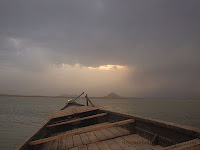Sambalpur derives its name from that of the Goddess Samaleswari, an incarnation of Shakti who is regarded as the reigning deity of the region. In history, it has been variously known as 'Sambalak', 'Hirakhanda', 'Udyānaa' or 'Uḍḍiyāna', 'Dakhin Kosal' and 'Kosal'. Sambalpur had also been known as 'Hirakhanda' meaning 'Land of Diamond', in the past Sambalpur was famous for diamond mining and trade. Even now, the adjoining areas yield a large volume of semi precious stones.
*******************************************************************************
Sambalpur is located at 21°- 3' North Latitude and 84°- 0' East Longitude in Western Odisha. The average elevation is 150.75 meters above the mean sea level. The geography of Sambalpur comprises of the following:-
- Rivers :- The Mahanadi;
- Hillocks :- Laxmi Dungri, Budharaja, Brooks Hill (Small hill);
- Plain Area :- Mandlia, Sunapali, Durgapali, Dhanupali, Makhnapara;
- Small Ponds :- 18;
- Big Ponds :- 8;
- Sea/Gulf :- Nil;
Sambalpur experiences extreme type of climate with hot and dry Summer followed by humid Monsoon and cold Winter. The hot season commences from 1st week of March and lasts till the second half of June. In the month of May, temperature rises up to 47°. Similarly in the month of December, the temperature comes down to 5°C.. Sambalpur gets rainfall from South-Western monsoon. The relative humidity is high during rainy season being generally over 75%. After rainy season the humidity gradually decreases and the weather becomes dry towards the winter. The best time to visit Sambalpur is between September to March.
*******************************************************************
The chief communicative language of the Sambalpur region is Sambalpuri Language. Not much research has been done on the accent and phonetics of this language, and it is generally considered to be a dialect of Oriya; however, recent research done at Sambalpur University claimed Sambalpuri as a distinct language and the University has subsequently introduced a one year diploma course in Sambalpuri Studies. Some linguist consider the spoken language of Sambalpur is the anicient form of modern Oriya language .
*********************************************************************
The economy of Sambalpur is basically dependent on agriculture and trade. Majority of the residents are either salaried or self employed. Forests play an important role in the economy in terms of contribution to revenue and domestic product. In the past Sambalpur has been a great centre of diamond trade. Kendu leaf or Coromandel Ebony or East Indian Ebony (Diospyros melanoxylon) also forms part of the economy of Sambalpur with many bidi manufacturing units functioning in Sambalpur . Kendu leaf is one of the most important non-wood forest products of Sambalpur district and is also called as green gold of Odisha. Lately industrialisation has started in the district and the prime industries of power, alumina and steel have been established. The place is famous for its globally renowned textile bounded patterns and fabrics locally known as Baandha. Sambalpur is famous for its Hand-loom textile works. Popularly known as Sambalpuri Textile.
*******************************************************************************
Education
- Sambalpur University
- Veer Surendra Sai University of Technology
- Gangadhar Meher College (Autonomous), Sambalpur
Women's College, Sambalpur NSCB College Hindi Teacher Training College, Sambalpur College of Agriculture, OUAT, Chiplima, Sambalpur B.Sc. (Ag.) Odisha Medical College of Homoeopathy & Research, Sambalpur VSS Medical College & Hospital, Sambalpur. Govt. College Physical Education, Kuksari, Sambalpur Lajpat Rai Law College, Sambalpur Silicon Institute of Technology, Sason, Sambalpur
Two things have contributed immensely to the fame of Sambalpur and enriched the cultural heritage one the origin of the Sitalsasthi festival(marriage of Lord Shiva with Goddess Parvati) and the origin of the world famous Sambalpuri textile and the Sambalpuri Sarees that enabled the Baandha art of Western Odisha march from its threshold of oblivion to its pinnacle of glory. Sambalpur has been at the centre of the custom, tradition, language and culture of Western Odisha. Several traits of the Sambalpur culture - Sambalpuri language, Sambalpuri dance, Sambalpuri songs or Sambalpuri sarees have held a national identity.
- Sambalpur Lok Mahotsav
- Sital Sasthi Carnival




